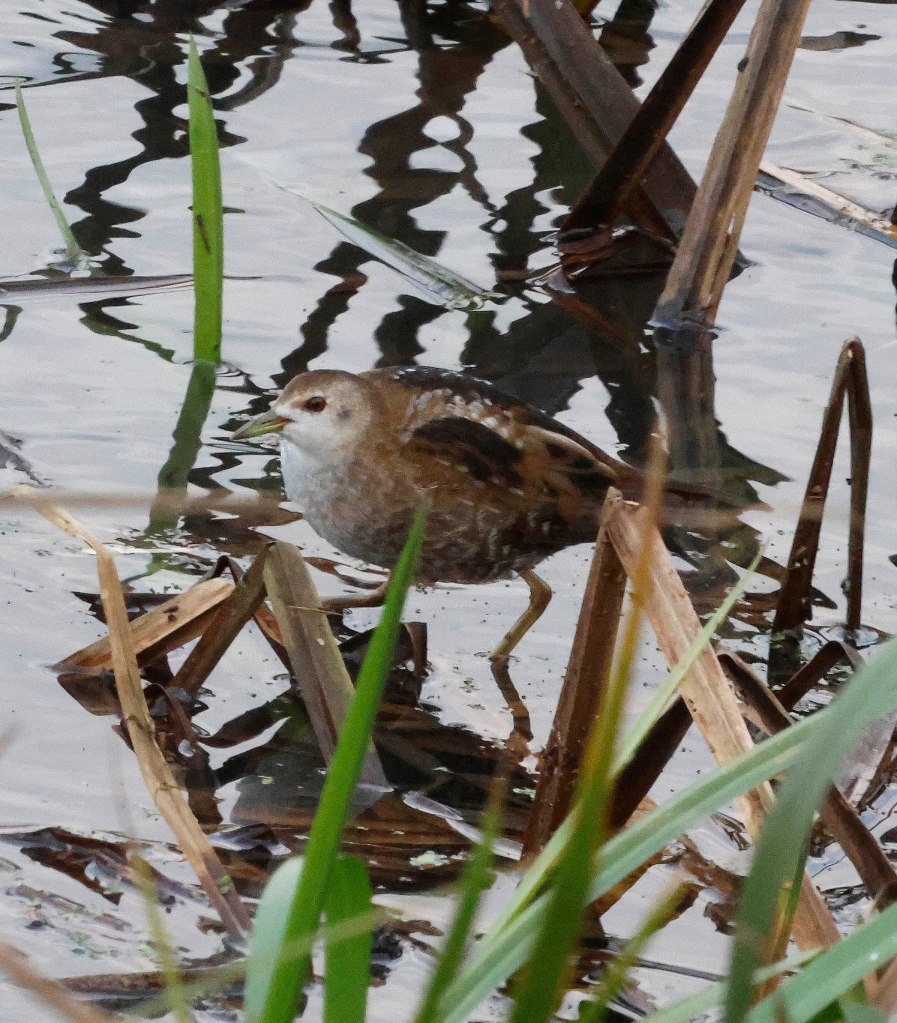At 48 miles from home this was an obvious British list addition to go for. I had recorded the bird just once before, it being one of my more memorable solo self-finds abroad at a remote location in western Cyprus in April 2012. But when news of one at a permit only reserve in Milton Keynes broke overnight on Tuesday (7th) I chose to wait for things to calm down a bit.
The hide in question would clearly be rammed for the first couple of days, which is not a situation I enjoy. Limited access times for non-members, with a queuing and rota system for viewing were off-putting constraints I didn’t want to deal with. When I twitched two of several available national Spotted Crake in the autumn of 2018 (see here) it was said migratory juveniles if in moult were likely to stick around for a while, so I hoped that would be the case again here.
By Thursday (9th) access had reverted to permit only that were purchasable online. This struck me as very sensible as it might serve to favour serious birders and deter more casual interest, quite apart from generating revenue for reserve upkeep and the work of the Parks Trust (see here) that manages it and other MK open spaces. So I decided to visit on Friday, needing to get out after a week spent mainly at home decorating. Linford Lakes NR (SP842428 – MK14 5AH) is a 37 hectare former gravel pit complex that was established as a wildlife research centre in 1970, and is described as the most bio-diverse site in the area.
I arrived just after 3pm to be greeted by friendly and helpful volunteer stewards, one of whom took me down to the Otter Hide. As we approached some birders came out who said my quest was showing close in. It seemed strange they should be leaving but that of course meant there would be more room inside. All seats were taken, with a few people standing behind and everyone was straining towards a spot in the lakeside vegetation where the Little Crake was said to be. I managed to secure a standing position with a clear view right in the corner of the hide, but couldn’t yet connect.
Amongst the seated birders I picked out Ewan, who had been in place since 7am, and some other familiar faces. Within 15 minutes the bird was called again moving back into view and now I saw it clearly. Then it rose in the air, almost hovering as it flew quite slowly to one side in a very Crake-like pose with legs dangling. This item was thus well and truly ticked for Blighty. Given such a quick conversion and my previous experience in Cyprus it must be a lucky species for me. All Crakes are of course skulkers and there had been long intervals between other observers in the hide getting their pictures.
With the light fading people now began to drift away, while I stayed until 4pm obtaining another brief and more distant sighting. The lateness of this day’s excursion was due to having waited in for delivery of a new camera lens. The 18 – 250mm Sigma baby zoom I have relied on since my previous Nikkor telefoto expired had followed suit earlier in the week. Now for a very reasonable £385 I have acquired a vgc used Nikkor 18 – 300mm all-in-one that should be a superior product. I find such entry level equipment very suitable for gaining this journal’s close-up images of insects, wild plants and fungi; but take it along on bird twitches too and see if I can get anything half decent. The previous three lenses of the last 13 years all jammed eventually, which seems to be their fate.
Little Crake breeds in freshwater wetlands across much of eastern Europe and into western Asia, wintering in north and north-eastern Africa. At 17 – 19cm they are smaller than the more frequent Spotted Crake, with a short greenish bill showing a red base and long wings, green legs with long toes, and a short tail that is barred black and white underneath. Adults have mainly brown upperparts and plain flanks, and juveniles barred flanks compared to the similar Baillon’s Crake. Face and underparts are plain slate grey in males, and buff to whitish in females and juveniles.
This is a scarce vagrant to the British Isles. The Milton Keynes bird, a county first for Bucks also offered a rare opportunity at an inland location. Having bought the permit it would clearly be sensible to come back for more and stay for longer if the Crake lingered. But it was not reported again so as things turned out I was doubly lucky. With this record, my 382nd British bird, I have now observed nationally all three of the wetland Crakes listed in Collins, and also have Corncrake as a heard only record.
Footnote: This twitch raised £3855 for the Parks Trust (see here), £2820 from 141 new site permits and £1035 in cash donations from visiting birders.

